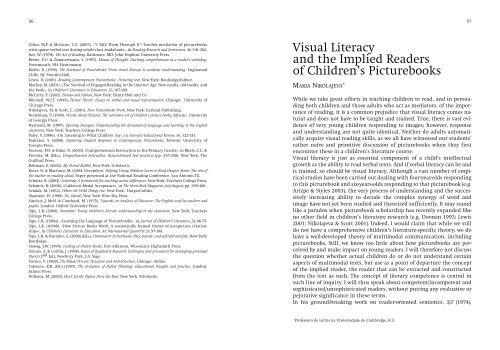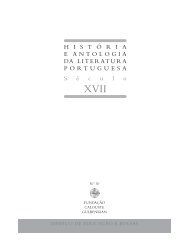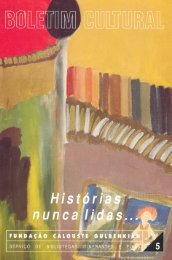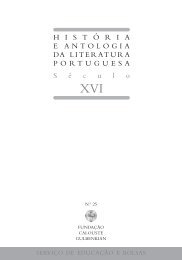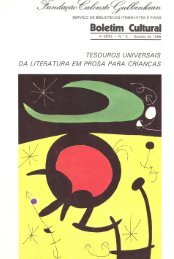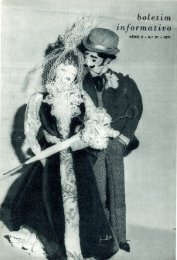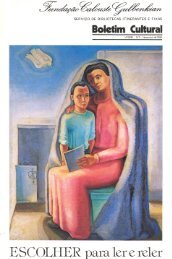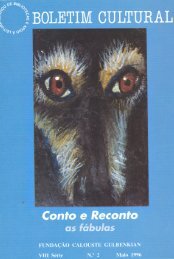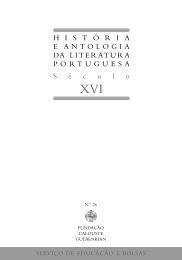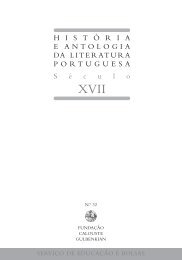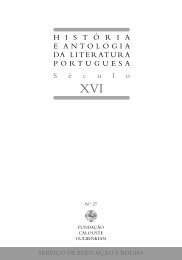Formar Leitores para Ler o Mundo - Leitura Gulbenkian - Fundação ...
Formar Leitores para Ler o Mundo - Leitura Gulbenkian - Fundação ...
Formar Leitores para Ler o Mundo - Leitura Gulbenkian - Fundação ...
Create successful ePaper yourself
Turn your PDF publications into a flip-book with our unique Google optimized e-Paper software.
56<br />
Ghiso, M.P. & McGuire, C.E. (2007). «“I Talk Them Through It”: Teacher mediation of picturebooks<br />
with sparse verbal text during whole-class readalouds», in Reading Research and Instruction, 46, 341-362.<br />
Iser, W. (1978). The Act of Reading, Baltimore, MD: John Hopkins University Press.<br />
Keene, E.O. & Zimmermann, S. (1997). Mosaic of Thought: Teaching comprehension in a reader’s workshop,<br />
Portsmouth, NH: Heinemann.<br />
Kiefer, B. (1995). The Potential of Picturebooks: From visual literacy to aesthetic understanding. Englewood<br />
Cliffs, NJ: Prentice-Hall.<br />
Lewis, D. (2001). Reading Contemporary Picturebooks: Picturing text. New York: Routledge/Falmer.<br />
Mackey, M. (2001). «The Survival of Engaged Reading in the Internet Age: New media, old media, and<br />
the book», in Children’s Literature in Education, 32, 167-189.<br />
McCarty, P. (2002). Hondo and Fabian, New York: Henry Holt and Co.<br />
Mitchell, W.J.T. (1995). Picture Theory: Essays on verbal and visual representation, Chicago: University of<br />
Chicago Press.<br />
Nikolajeva, M. & Scott, C. (2001). How Picturebooks Work, New York: Garland Publishing.<br />
Nodelman, P. (1988). Words About Pictures: The narrative art of children’s picture books, Athens: University<br />
of Georgia Press.<br />
Nystrand, M. (1997). Opening Dialogue: Understanding the dynamics of language and learning in the English<br />
classroom, New York: Teachers College Press.<br />
Paley, V. (1986). «On Listening to What Children Say», in Harvard Educational Review, 56, 122-131.<br />
Pantaleo, S. (2008). Exploring Student Response to Contemporary Picturebooks, Toronto: University of<br />
Toronto Press.<br />
Pearson, P.D. & Duke, N. (2003). «Comprehension Instruction in the Primary Grades», in Block, C.C. &<br />
Pressley, M. (Eds.), Comprehension Instruction: Research-based best practices (pp. 247-258), New York: The<br />
Guilford Press.<br />
Rohman, E. (2002). My Friend Rabbit, New York: Scholastic.<br />
Roser, N. & Martinez, M. (2004, December). Helping Young Children Learn to Read Chapter Books: The role of<br />
the teacher in reading aloud. Paper presented at the National Reading Conference, San Antonio,TX.<br />
Schultz, K. (2003). Listening: A framework for teaching across differences, New York: Teachers College Press.<br />
Selznick, B. (2008). «Caldecott Medal Acceptance», in The Horn Book Magazine, July/August, pp. 393-406.<br />
Sendak, M. (1963). Where the Wild Things Are, New York: HarperCollins.<br />
Shannon, D. (1998). No, David!, New York: Blue Sky Press.<br />
Sinclair, J. McH. & Couthard, M. (1975). Towards an Analysis of Discourse: The English used by teachers and<br />
pupils, London: Oxford University Press.<br />
Sipe, L.R. (2008). Storytime: Young children’s literary understanding in the classroom, New York: Teachers<br />
College Press.<br />
Sipe, L.R. (1998a). «Learning the Language of Picturebooks», in Journal of Children’s Literature, 24, 66-75.<br />
Sipe, L.R. (1998b). «How Picture Books Work: A semiotically framed theory of text-picture relationships»,<br />
in Children’s Literature in Education: An International Quarterly 29, 97-108.<br />
Sipe, L.R. & Pantaleo, S. (2008) (Eds.). Postmodern Picturebooks: Play, parody, and self-referentiality, New York:<br />
Routledge.<br />
Stewig, J.W. (1995). Looking at Picture Books, Fort Atkinson, Wisconsin: Highsmith Press.<br />
Strauss, A. & Corbin, J. (1998). Basics of Qualitative Research: Techniques and procedures for developing grounded<br />
theory (2 nd Ed.), Newbury Park, CA: Sage.<br />
Turner, V. (1969). The Ritual Process: Structure and Anti-Structure, Chicago: Aldine.<br />
Valencia, R.R. (Ed.) (1997). The Evolution of Deficit Thinking: Educational thought and practice, London:<br />
Falmer Press.<br />
Willems, M. (2003). Don’t Let the Pigeon Drive the Bus!, New York: Scholastic.<br />
Visual Literacy<br />
and the Implied Readers<br />
of Children’s Picturebooks<br />
MARIA NIKOLAJEVA*<br />
While we take great efforts in teaching children to read, and in persuading<br />
both children and those adults who act as mediators, of the importance<br />
of reading, it is a common prejudice that visual literacy comes natural<br />
and does not have to be taught and trained. True, there is vast evidence<br />
of very young children responding to images; however, response<br />
and understanding are not quite identical. Neither do adults automatically<br />
acquire visual reading skills, as we all have witnessed our students’<br />
rather naïve and primitive discussion of picturebooks when they first<br />
encounter these in a children’s literature course.<br />
Visual literacy is just as essential component of a child’s intellectual<br />
growth as the ability to read verbal texts. And if verbal literacy can be and<br />
is trained, so should be visual literacy. Although a vast number of empirical<br />
studies have been carried out dealing with four-year-olds responding<br />
to this picturebook and six-years-olds responding to that picturebook (e.g.<br />
Arizpe & Styles 2003), the very process of understanding and the successively<br />
increasing ability to decode the complex synergy of word and<br />
image have not yet been studied and theorized sufficiently. It may sound<br />
like a <strong>para</strong>dox when picturebook scholarship has recently expanded like<br />
no other field in children’s literature research (e.g. Doonan 1993; Lewis<br />
2001; Nikolajeva & Scott 2001). Indeed, I would claim that while we still<br />
do not have a comprehensive children’s literature-specific theory, we do<br />
have a well-developed theory of multimodal communication, including<br />
picturebooks. Still, we know too little about how picturebooks are perceived<br />
by and make impact on young readers. I will therefore not discuss<br />
the question whether actual children do or do not understand certain<br />
aspects of multimodal texts, but use as a point of departure the concept<br />
of the implied reader, the reader that can be extracted and constructed<br />
from the text as such. The concept of literary competence is central in<br />
such line of inquiry. I will thus speak about competent/incompetent and<br />
sophisticated/unsophisticated readers, without putting any evaluative or<br />
pejorative significance in these terms.<br />
In his ground-breaking work on reader-oriented semiotics, S/Z (1974),<br />
*Professora de Letras na Universidade de Cambridge, R.U.<br />
57


